Contents
Raspberry Nugget is a remontant variety of culture that many gardeners have been able to appreciate. It is characterized by large size of berries, unpretentious care, high and stable yield and long fruiting period. To achieve the effectiveness of the variety, it is necessary to follow the rules of planting and further care.
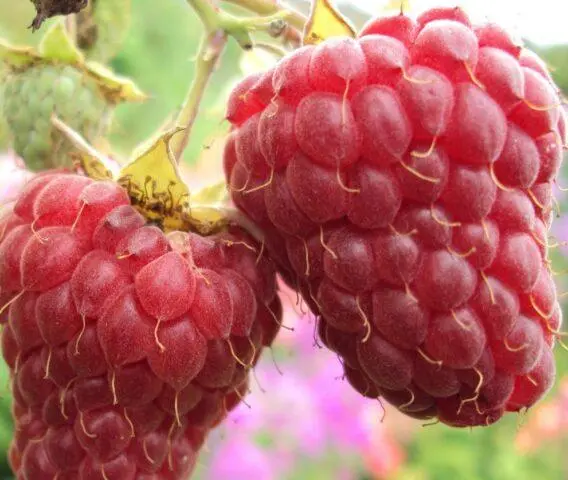
Nugget – a new promising type of remontant raspberry
History of occurrence
This variety is the result of the work of breeders. Raspberry Nugget was bred at the Kokinsky stronghold of the GNU VSTISP of the Agricultural Academy. The purpose of creating the species was to obtain a highly productive remontant berry with increased resistance to adverse weather conditions. And the creators succeeded. The resulting type of raspberries fully met expectations, for which the Nugget was named.
Description Raspberry Nugget
Raspberry Nugget, like other remontant species, is able to bear fruit until frost. In order for the shrub to fully develop and regularly yield crops, it is necessary to take into account the size of its bushes when planting in order to properly plant plants on the site. You should also pay attention to the characteristic differences of the Nugget.
Berries
This raspberry belongs to the category of large-fruited. The average weight of berries reaches 13 g. The fruits of the Nugget are conical in shape, when ripe they acquire a dark cherry hue. The seeds of this raspberry variety are small, when eaten they are not felt. The taste of Nugget berries is sweet, with a slight sourness, the aroma is moderate.
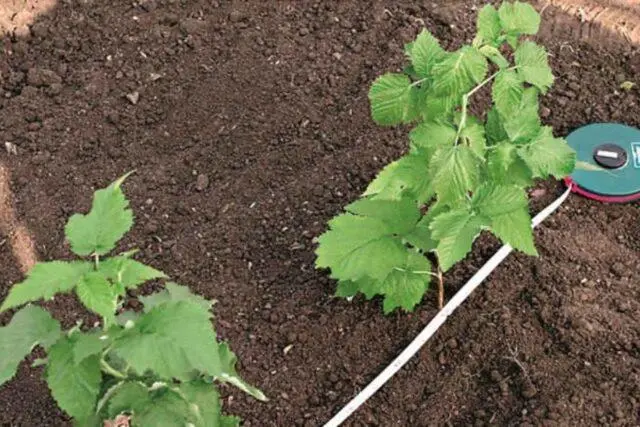
The fruits hold well on the branches, do not crumble when ripe.
Bush
Raspberry Nugget belongs to the category of medium-sized species. The height of its bushes reaches 1,5 m. The shoots are strong, they do not need support. The branches are erect, the angle of their deviation from the vertical is no more than 12-18 degrees.
The leaves are large oval. The plates are complex, consisting of 5-7 ovoid individual segments. Raspberry Nugget leaves have a rich dark green hue on top, and on the reverse side they are whitish and covered with small villi. Thorns are sharp, located along the entire length of the shoots.
The flowers of the raspberry Nugget are bisexual. The diameter of the buds when fully opened reaches 1 cm. The flowers are simple, consisting of five white petals. They are collected in racemose inflorescences, which are formed on the tops of the shoots and in the axils of the leaves.
The fruit branches of the raspberry Nugget reach 30 cm in length. Each of them produces 15-20 berries.
Characterization
To get a complete picture of this new variety of remontant raspberries, you need to study its characteristics. This will allow you to compare its productivity with other types of culture. Also, this information will help ensure proper care of the plant.
Ripening time and yield of raspberry Nugget
This species is considered mid-season. The first fruits on raspberry bushes Nugget ripen at the end of July. The variety bears fruit until late autumn, until frosts begin. The yield of the variety is high. From one bush per season, you can collect up to 4 kg of berries.
The crop tolerates transportation well without a sharp decrease in commercial qualities. Nugget fruits are suitable for freezing, as they retain their shape well.
Frost resistance
Remontant raspberries are recommended for cultivation in the central regions of the country. It withstands frosts down to -25 °C. It is permissible to grow it in the northern regions, but with the condition of obtaining one crop and warming the root system for the winter.
Resistance to diseases
Raspberry Nugget has a high natural immunity. But if the growing conditions do not match, the resistance of the variety to diseases decreases. To prevent this, experienced gardeners recommend spraying bushes with fungicides during the growing season.
Advantages and disadvantages
Raspberry Nugget has many advantages. But it also has some shortcomings that you need to pay attention to so that later they do not become an unpleasant surprise.
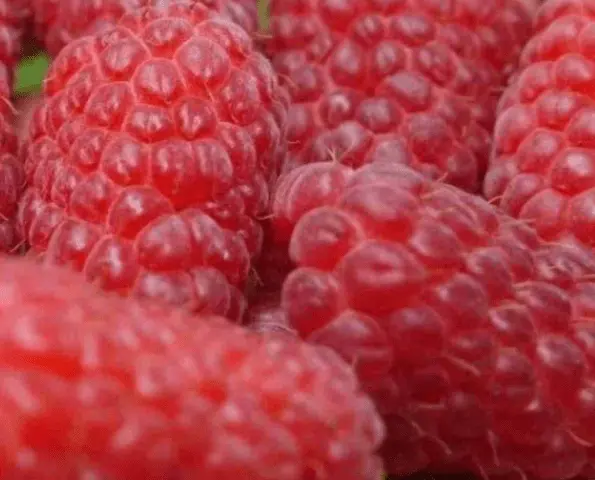
The output of marketable products at Nugget is 90%
The main advantages:
- large-fruited;
- dessert taste and moderate aroma;
- long and stable fruiting;
- high natural immunity;
- undemanding to care;
- the ability to produce a crop twice a season;
- suitable for fresh consumption and processing;
- shoots do not need support.
Disadvantages:
- berries are not always well separated from the stalk;
- thorns complicate the collection of fruits.
Features of growing raspberries Nugget
This variety does not require complex care. But in order to obtain a high stable yield, certain rules of agricultural technology must be observed.
Rules of landing
Raspberry Nugget is one of the light-loving crops. For its planting, you should choose a sunny open area, protected from drafts. At the same time, it is important that the groundwater level in the garden is at least 0,6 m.
You can take seedlings to a permanent place in spring or autumn. In the first case, the second half of April is a favorable period, and in the second – the end of September, the beginning of October, but at least three weeks should remain before the onset of frost.
Two weeks before the procedure, you need to prepare a landing pit. It should be 40 by 40 cm in size. Lay crushed stone at the bottom of it, and fill the rest of the space with a nutrient mixture consisting of turf, humus, sand and peat in a ratio of 2: 1: 1: 1. Also, in addition, 100 g of wood ash should be added to the hole and carefully moved.
When planting, the root neck of the seedling should be at the level of the soil. After the procedure, raspberry Nugget should be watered abundantly and the soil at the base of the seedling should be mulched with peat to prevent the roots from drying out.
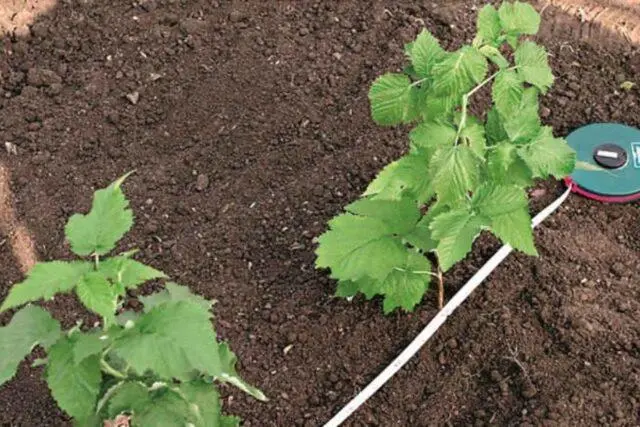
Bushes need to be planted at a distance of 70 cm
How to care
Raspberry Nugget should be watered moderately. In the first month after planting, moisturizing is recommended once a week, and then double the frequency. Adult bushes need good watering only before flowering and during the formation of the ovary in the absence of seasonal rains.
Throughout the season, you need to loosen the soil between the bushes and remove growing weeds. Raspberry Nugget needs good nutrition, which guarantees high productivity of the variety. It is recommended to fertilize bushes during the period of active growth of shoots with organic matter and nitroammophos. And throughout the summer, plants should be watered with superphosphate (40 g) and potassium sulfide (35 g) per 10 liters of water. Feeding is carried out at intervals of once every three weeks.
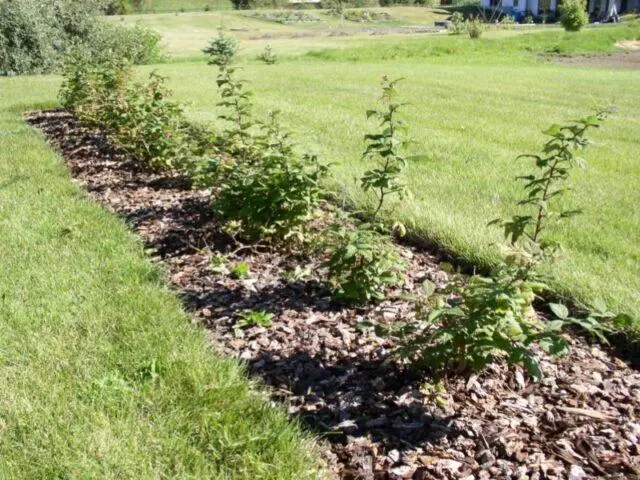
Raspberry Nugget does not respond well to waterlogging of the soil
Immediately after fruiting, the shoots must be cut at the base. Only young shoots should be left, no more than 6-8 pieces. on a plant. Before winter, the soil at the base of the bushes should be mulched with peat or humus. The layer thickness should be 6 cm.
Reproduction
Nugget raspberries can be planted with young shoots that grow during the season. To do this, you need to dig it out with part of the root and move it to a new place.
This variety can also be propagated from root cuttings. This method is recommended to be applied in early spring before the start of the growing season. To get new seedlings, you should dig up a raspberry bush on one side so that the root is exposed and cut off a part of it 20 cm long with two or more live buds. After that, immediately plant the stalk in a permanent place, water it abundantly and cover with agrofiber.
Prevention of diseases and pests
To maintain the high immunity of raspberry Nugget to diseases and pests, it is necessary to treat it with iron sulfate in the spring. During this period, a 1% solution of the drug should be used. Processing is carried out, before bud break at a temperature of + 5-10 ° C.

Iron vitriol is distinguished by high efficiency and affordable price
Conclusion
Raspberry Nugget is a noteworthy crop variety that is able to show high performance with proper care. Even a novice gardener is quite capable of growing this species. To do this, it is enough to adhere to the standard rules of agricultural technology, and then the resulting crop will meet expectations.









